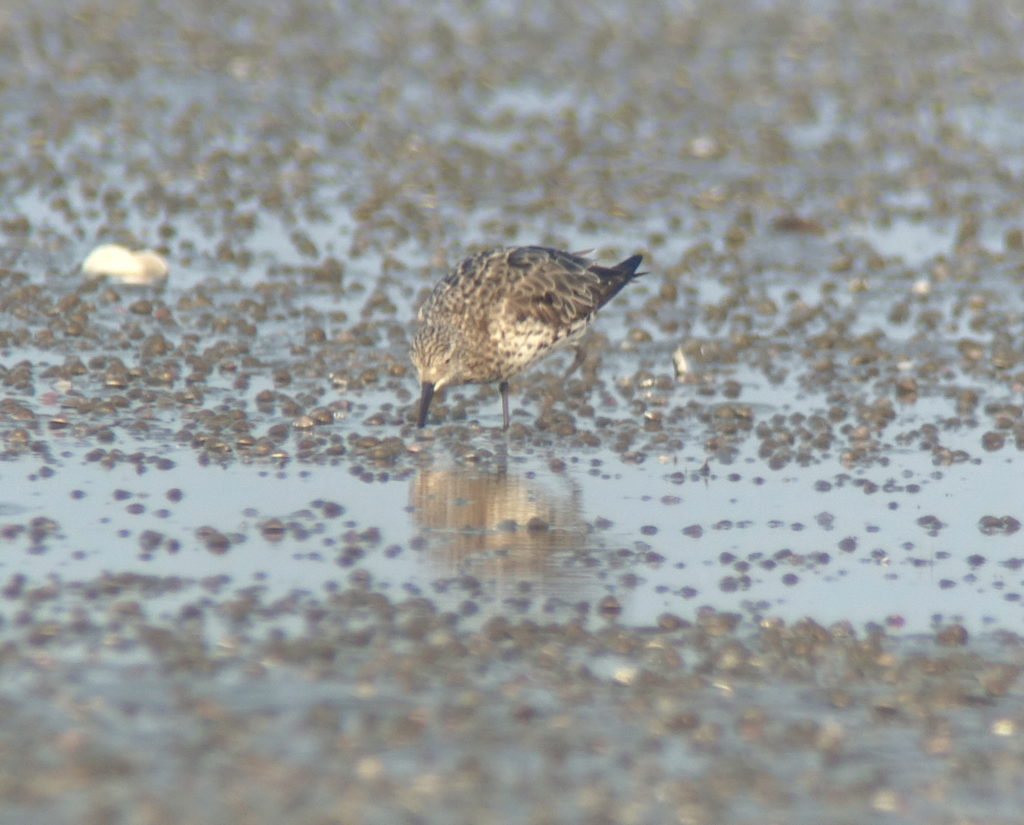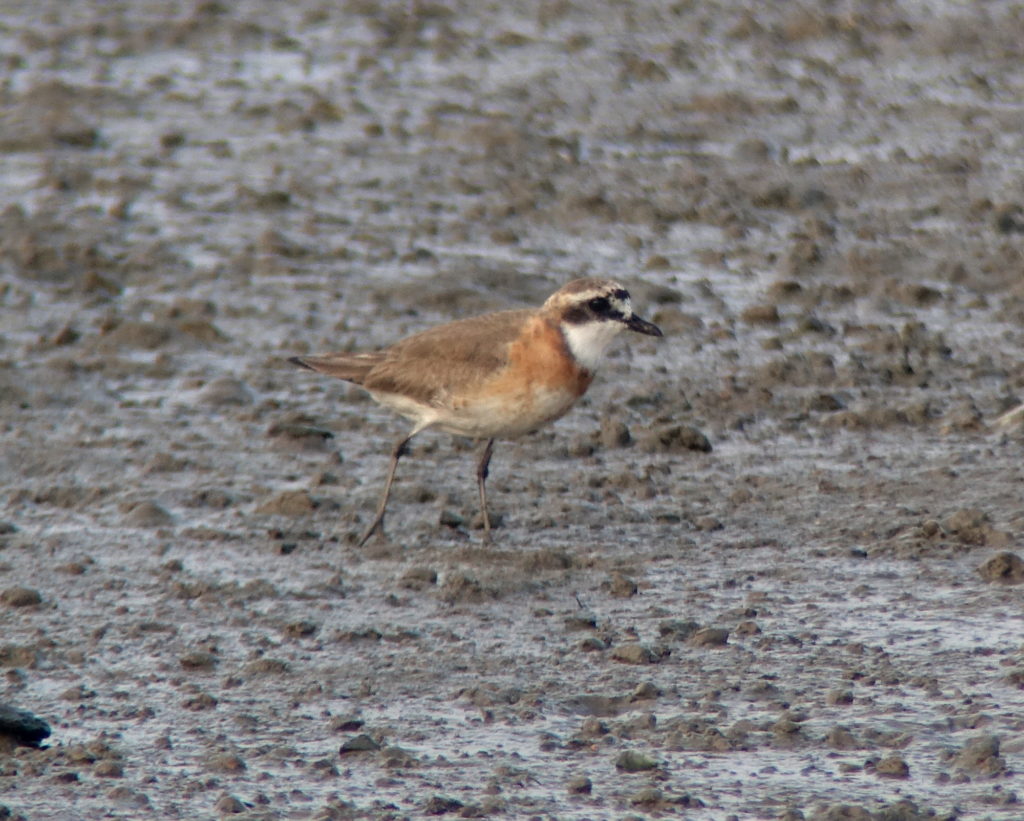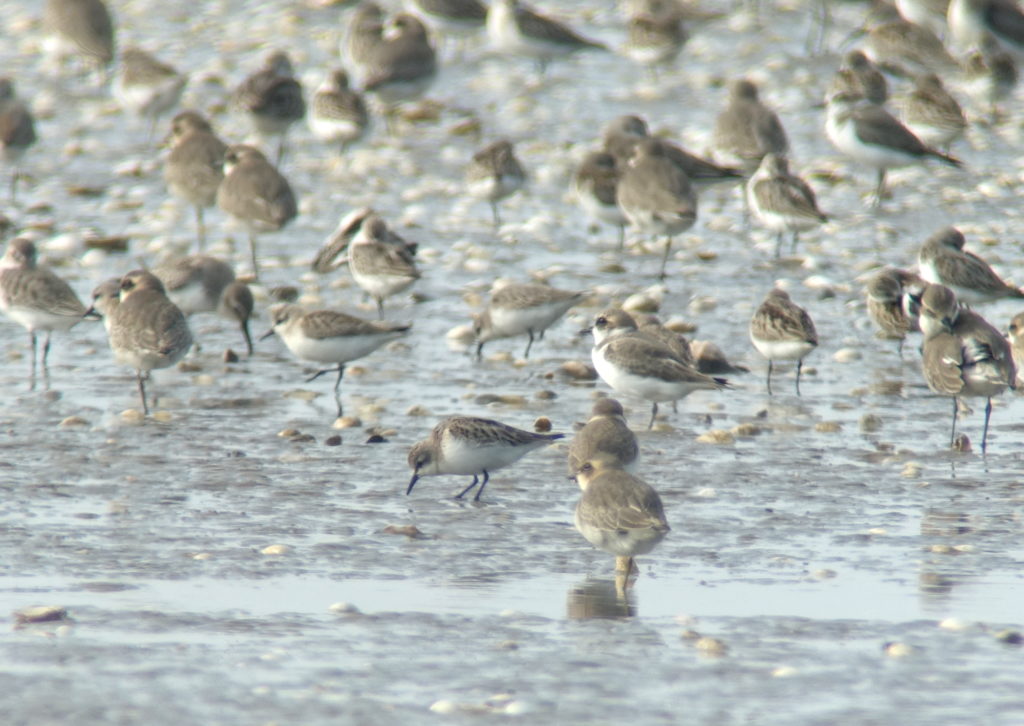Bird News from Nial Moores with Per Kaijser and Jared Busen
A total of 34 shorebird species (out of a total 110 bird species logged) were found, with shorebird highlights that included a Pectoral Sandpiper below the Geum Barrage at dusk on 27th (NM & JB only); and 3+ Spoon-billed Sandpiper, 4+ Nordmann’s Greenshank, one (or two?) Little Stint and rarest of all in the Korean context a Common Ringed Plover, all on Yubu on 28th.
Following a request from PK for two days’ guiding focused on shorebirds, NM and JB (an active Birds Korea volunteer, who has been conducting counts of waterbirds at the Hwaseong Wetland) first met up near the Geum Barrage at dusk on the 27th, finding c. 5,000 shorebirds out on the mud. These included a single Red Knot (increasingly scarce in the ROK) and best of all a distant Juvenile>First-winter Pectoral Sandpiper. PK arrived later in the evening.

Before sunrise on the 28th, the three of us crossed to Yubu and did the mud-march as the tide allowed. With an hour or so, we located our most-wanted species, a Spoon-billed Sandpiper. This individual (perhaps a First Calendar-year in non-breeding plumage?) was even more active than usual, rising, twisting and spinning like a diminutive ballet dancer for more than 20 minutes – provoked it seems by erratic spurts of water ejected from thousands of hidden burrows. Absolutely superb.



A few hundred meters away, another Spoonie was seen walking and sprinting across the tidal flats, and thirty minutes later, further off, first two and then, rather further off still, perhaps an additional three possible spoonies were seen (including one which at 70X seemed to show more contrast, like a bird still with some juvenile plumage, perhaps with a green or blue leg flag that seemed to catch the low morning sun). Crawling over – and at times under! – the mud, we approached this area of concentration but could find ‘’only’’ the closer two Spoonies, both of which were more obviously adult types in full non-breeding plumage, and neither of which were adorned with plastic. There were several Sanderling in the same area too – confusable at long range in harsh light with SBS. Might the leg- flagged bird have been a Sanderling too?
Either way, we can be certain that there were at least three Spoonies. It seems almost as likely that there were five, or perhaps even six
Also seen at low tide were decent numbers of Great Knot (an estimated 4,000 in total), up to 70 Red Knot (my personal highest count of the species in the ROK for at least a decade), and at least three Nordmann’s Greenshank, out of 4+ seen during the day.


High tide was magnificent, confirming it as PK’s “Best day of shorebirding ever, anywhere”.

Mixed in with the throng of Dunlin (c. 20,000) and Kentish (5,000+) and Mongolian Plovers (a conservative 2,000 estimated) were hundreds of Broad-billed Sandpiper, 1,000 + Red-necked Stint, one (or two) Little Stint and rarest of all in the Korean context, a Common Ringed Plover (perhaps my first in a decade, even though I saw the species ~5 times between 1998 and 2006).




These ‘’smalls’ were then joined by the giants of the shorebird world – at least 3,250 Far Eastern Curlew (close to 10% of the world population) and 2,800 Eurasian Curlew, the latter mixed in with almost 2,000 Far Eastern Oystercatcher, 110 Black-faced Spoonbill and egrets, including 17 Chinese Egret. Counts of all these, and additional, species are listed in eBird (Checklist S60253224).
On the 29th, local woodland in Gunsan was quiet, apart from an exceptional number of Red Squirrel, good numbers of woodpeckers, a migrant flock of 130 Brown-eared Bulbul and a lone Mugimaki Flycatcher.
Seosan Lake A Reclamation Area was much better. In addition to several “new” shorebird species (including a Long-toed Stint, two dusky Spotted Redshank, and several small troops of Marsh Sandpiper), we also enjoyed a wonderful mix of species, including several scarcities: single Swan Goose and Baikal Teal, Pied and Eastern Marsh Harrier and a Chinese Grey Shrike.

PK had made one additional request that still had not been met – to see, finally, an Arctic Warbler. We therefore cancelled our planned long drive up to Asan Bay reclamation ponds (where Dr Shim Kyu-Sik photographed a Little Stint perhaps on the 23rd) and the Hwaseong Wetlands, where Park Heungsik photographed Korea’s 3rd (?) record of Black-winged Kite on 21st.
Instead, we stopped at a small patch of riverside trees at the edge of the reclamation area. Success: within a minute or two a calling and (briefly) viewable Arctic Warbler… “the sprinkles on top of the cream on top of PK’s Korean birding cake”!
All in all an excellent weekend: excellent company, stunning birds and even some nice scenery!
